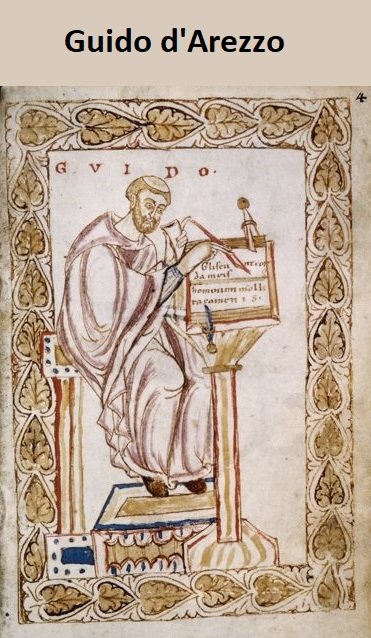But where do the names of the musical notes come from?
Friends Steemians good morning and welcome back!
But have you ever wondered where the names of musical notes come from? Why did someone choose to call them Do-Re-Mi-Fa-SOl-La-Si?
I've always wondered since I was a child when the first approaches to this wonderful art / science began at school.
Once I also asked my music teacher but he could not answer me other than it was Guido d'Arezzo to give these names to the notes.
Then caught by my insatiable curiosity, I began a series of rather difficult researches because finding books that talked about it was not simple.
In the early 90s the internet was not yet present for us mere mortals ... and certain books also cost a lot!
But culture, you know, is priceless!
Before the Middle Ages, music and songs were transmitted exclusively in oral form because the man had not yet invented a system for writing music. With the arrival of the medieval era, with the evolution of music in increasingly complex forms, we felt the need to find a way to put music on paper, to write it and then read it in a universal way.
Clearly at the beginning it was not as we know today the musical notation, but they were simple signs written over the texts to be sung that indicated the progression of the ascending and descending melody. These symbols were called "neumi".

Around the year 1000, a monk named Guido d'Arezzo, gave shape to the music system in a way very similar to what we know today. It was he who first gave a name to the notes of the diatonic scale, which Pythagoras first and then Zarlino had previously built.
Pythagoras defined the seven degrees of the diatonic scale based on the length of the vibrating strings and here he realized that by vibrating a string for half of its length, the sound generated by it is the same but one octave higher.
On the other hand, Zarlino, realizing that Pythagoras' scale presented intonation problems, created the natural scale, this one no longer based on mathematical relationships but on the succession of natural harmonics that generates a note.
This system also presented intonation problems such as to have to gradually reach the current tempered system.

Guido d'Arezzo gave the current names of the notes used in Latin countries; they correspond to the initial syllables of the first six verses of the hymn Ut Queant Laxis, composed by the monk Paolo Diacono:
« Utqueant laxis
Resonare fibris
Mira gestorum
Famuli tuorum
Solve polluti
Labii reatum,
Sancte Iohannes »
From the Latin: In order that your servants may sing with marvelous voices the marvels of your actions, erase sin, O holy John, from their unworthy lips.
From the seventeenth century, the Ut was later called Gd by the theorist Gian Battista Doni (initials of his surname).

Here are Steemians friends a brief history on the names of the notes! Thank you for reading my post, I hope I have done a pleasure.
See you soon! Bye!
Da dove provengono i nomi delle note musicali?
Amici Steemians buongiorno e ben ritrovati!
Ma vi siete mai chiesti da dove derivano i nomi delle note musicali? Perchè qualcuno ha scelto di chiamarle Do-Re-Mi-Fa-SOl-La-Si?
Me lo sono sempre chiesto fin da bambino quando a scuola si cominciavano i primi approcci con questa meravigliosa arte/scienza.
Una volta lo chiesi anche al mio insegnante di musica ma non seppe rispondermi altro che fu Guido d'Arezzo a dare questi nomi alle note.
Allora preso dalla mia insaziabile curiosità, cominciai una serie di ricerche, piuttosto difficoltose perchè trovare libri che ne parlassero non era semplice.
Nei primi anni '90 internet non era ancora presente per noi comuni mortali....e determinati libri costavano anche parecchio!
Ma la cultura, si sà, non ha prezzo!
Prima del Medioevo, la musica ed i canti venivano trasmessi esclusivamente in forma orale in quanto l'uomo non aveva ancora inventato un sistema per scrivere la musica. Giunta l'era medievale, con l'evolversi della musica in forme sempre più complesse, si sentiva la necessità di trovare un modo per mettere su carta la musica, per scriverla e successivamente leggerla in modo universale.
Chiaramente all'inizio non era così come conosciamo oggi la notazione musicale, ma erano semplici segni scritti sopra i testi da cantare che ne indicassero l'andamento della melodia sia ascendente che discendente. Questi simboli erano chiamati "neumi".

Intorno all'anno 1000, un monaco chiamato Guido d'Arezzo, diede forma al sistema musicale in modo del tutto simile a quello che conosciamo noi oggi. Fu lui che per primo diede un nome alle note della scala diatonica, che prima Pitagora e poi lo Zarlino avevano precedentemente costruito.
Pitagora definì i sette gradi della scala diatonica in base alla lunghezza delle corde messe in vibrazione e qui si accorse che facendo vibrare una corda per metà della sua lunghezza, il suono da essa generato è lo stesso ma di un’ottava superiore.
Lo Zarlino invece, accorgendosi che la scala di Pitagora presentava problemi di intonazione, creò la scala naturale, questa non più basata sui rapporti matematici ma sulla successione degli armonici naturali che genera una nota.
Anche questo sistema presentò problemi di intonazione tali da dover giungere poco a poco all'attuale sistema temperato.

Guido d'Arezzo diede gli attuali nomi delle note in uso nei paesi latini; esse corrispondono alle sillabe iniziali dei primi sei versetti dell'inno Ut Queant Laxis, composto dal monaco Paolo Diacono:
«Ut queant laxis
Resonare fibris
Mira gestorum
Famuli tuorum
Solve polluti
Labii reatum,
Sancte Iohannes»
Dal Latino: Affinché i tuoi servi possano cantare con voci libere le meraviglie delle tue azioni, cancella il peccato, o santo Giovanni, dalle loro labbra indegne.
A partire dal XVII secolo, l’ Ut venne poi chiamato Do dal teorico Gian Battista Doni (iniziali del suo cognome).

Ecco amici Steemians una breve storia sui nomi delle note! Grazie per aver letto il mio post, spero di aver fatto un piacere.
A presto! ciao!
Congratulations @hjmarseille! You have completed the following achievement on the Steem blockchain and have been rewarded with new badge(s) :
You can view your badges on your Steem Board and compare to others on the Steem Ranking
If you no longer want to receive notifications, reply to this comment with the word
STOPTo support your work, I also upvoted your post!
Che bel post! Non immaginavo minimamente che fosse questa la storia delle note musicali ahah
Grazie!
Very interesting information; One of the better posts in music today!
Thanks!
This post was shared in the Curation Collective Discord community for curators, and upvoted and resteemed by the @c-squared community account.
If you are a community leader and/or contest organizer, please join the Discord and let us know you if you would like to promote the posting of your community or contest.
@c-squared runs a community witness. Please consider using one of your witness votes on us here
Questo post è stato condiviso e votato all'interno del discord del team curatori di discovery-it.
This post was shared and voted inside the discord by the curators team of discovery-it
bellissimo e istruttivo post....sono un'amante della musica ma non conoscevo minimamente la storia delle note...grazie!!!
Grazie a te,come sempre!